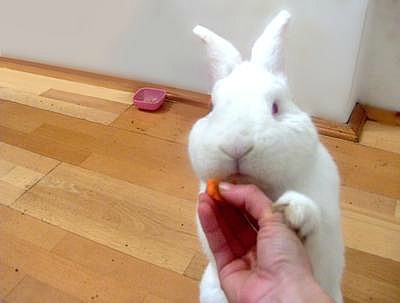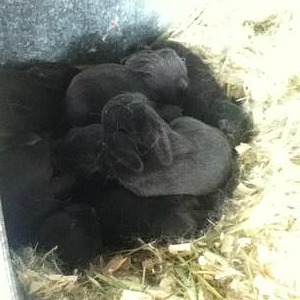Know Your Pet Rabbits
I hope you are enjoying your rabbits! They are wonderful creatures. Despite being livestock animals, they make very cool pets. But as you’ve probably noticed, they aren’t the same kind of pet as are your dogs or even cats. They are a different sort of pet:
- Dogs and cats are predators, while rabbits are prey. As prey, they can be timid and fearful. Cater to their natural timidity, at least until the rabbit has become very comfortable with its environment.

- Rabbits tend naturally to take lots of down time. They are most active at dawn and dusk, and otherwise act quite chill. This lends itself to busy schedules and school schedules because they sleep while you’re away.
- Rabbits are primarily governed by their primal instincts. They can be trained to a certain extent, but schutzhunds they are not. You can teach them to jump over little hurdles (rabbit jumping), and you can easily litter-box-train them, but you’d best place a litter box in every single room the house rabbit has access to, because when the urge hits, it won’t travel far before relieving itself.
- Domestic rabbits burrow when they live in the wild. This keeps them warm in winter and cool in summer. Summer in hot climates is particularly perilous for rabbits as they can easily overheat and die if they cannot stay cool.
Provide various combinations of cooling methods when the ambient temperature rises above 88 F, to keep the rabbit's environment at 88 F or below.
On the other hand, why not create an underground home for each rabbit? You’ll find plans for one style of homemade burrow in our e-book, Ideal DIY Rabbit Cages.
All that said, keeping rabbits as pets can be extremely rewarding for their gentleness and their friendly antics. Accept their intellectual limitations, minimize their fears and anxieties, and maintain a predator-safe environment, and you’ll have set up a win-win-win situation for all.
The rabbitry pictured below is covered in greenery,
and remains cool even on warm days.

Overheard
“I raise meat rabbits. It’s healthier. I know what they ate and how they were raised. I butcher myself and am learning how to pressure-can the meat for future needs when there are too many. I am learning about the fertilizer and worming in manure. Knowing that I am providing meat for my family is a good feeling” (Nan, from Texas).
Are you not a homesteader? Don’t raise rabbits? You can still provide a raw yet safe and health-promoting diet for your pet dogs and cats, by obtaining raw frozen rabbit directly from a network of rabbit breeders. The details are here.
Healthy Rabbits
When Kits Leave the Nesting Box too Early
Maggie in North Dakota writes:
“Eleven days ago my doe gave birth to 7 perfect little kits. Yesterday (day 10) three kits were out of the nest box so I put them back in; I assumed they fell out when they wanted more milk. Today (day 11) six of them were out of the box. A couple do not have their eyes open yet. I don't know what to do; they are jumping out so early.”
Maggie is right, they may have been dragged out while still latched onto the doe. The doe might drag out one or two, but, dragging out all 6 of ‘em at once? That would be unusual.
Another possibility is that the nesting box got quite warm on a summer day. When that happens, the kits turn into little jumping beans, becoming very active in the nest. They may have been able to pop out of the nest.
Pictured below: Maggie's kits at 11 days old.
 The general rule of thumb is that the kits should stay in the nest box until the first kit gets out.
The general rule of thumb is that the kits should stay in the nest box until the first kit gets out.
BUT, day 10 is very early! Maggie did well to put the kits back into the nest.
Day 11 is also very early.
Given the penchant of this litter for escape artistry, I might have simply lined the entire cage with a layer of straw and/or hay, and either removed the nesting box or tipped it on the side, so the kits could go in and out easily.
The lining of hay/straw is because the kits’ feet are so small at this age that they can get stuck up to the hocks in the 1/2" x 1" cage floor wire, and not be able to get free. If this happens, the struggling kit might even break a bone. Lining the cage prevents the little feet from getting stuck. Once they’ve reached 14 days of age, their extremities are big enough to avoid getting caught in the wire.
Rabbit
Raising Problem Solver answers all sorts of questions about nest box preparation and taking care of the litter until it no longer needs the nesting box.
Rabbits in the News
“Rabbits, it turns out, are a gateway animal.”
So starts a delightful article that captures well the “tranquility, authenticity, togetherness and…earthy romanticism” that can be found in microfarming today.
Why are rabbits a gateway animal?
“Because those lead to chickens. Then goats. Then a pregnant sow.”
Before they knew it, two Maryland lawyers had bought a 2-acre property and commenced micro-farming with their 5 children.
Read the whole article here. We thoroughly enjoyed it, and hopefully you will too.
Like this newsletter?
Maybe your friends would too...
Your friends at Raising-Rabbits.com wish you a wonderful June 2015.
Enjoy your rabbits!
|



 The general rule of thumb is that the kits should stay in the nest box until the first kit gets out.
The general rule of thumb is that the kits should stay in the nest box until the first kit gets out.